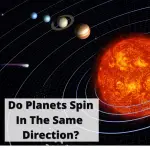There is so much to learn about the sun, this vital and bright fixture in the sky.
In this article, we’ll answer more than 50 of the most interesting questions about the sun we could find.
Fun Facts About The Sun Everyone Should Know
What Is The Sun Made Of?
The sun is mostly made of hydrogen and helium.
About 74% of the sun’s mass is hydrogen, and about 24% is helium.
The remaining 2% is made up of other elements, including oxygen, carbon, neon, and iron.
What Is The Sun’s Surface Temperature?
The sun’s surface temperature is about 5,500 degrees Celsius.
However, the temperatures in the sun’s atmosphere can be much higher.
The sun’s core, where nuclear fusion takes place, has a temperature of about 15 million degrees Celsius.
How Big Is The Sun?
The sun has a diameter of about 1.4 million kilometers.
It’s so big that it could fit about 1.3 million Earths inside of it.
In fact, the sun makes up about 99.86% of the mass of the entire solar system.
How Bright Is The Sun?
The sun is incredibly bright.
It’s so bright that it’s difficult to look at it directly with the naked eye. In fact, staring at the sun can damage your eyes.
The sun is so bright because it emits a lot of energy.
It emits more energy in one second than humans have used in the entire history of civilization.
What Is The Sun’s Atmosphere Like?
The sun’s atmosphere consists of multiple layers, including the photosphere, chromosphere, and corona.
The photosphere is the lowest layer of the sun’s atmosphere and it’s where we see sunspots.
The chromosphere is a layer of gas above the photosphere that’s often seen during solar eclipses.
What Would Happen If The Sun Disappeared?
If the sun disappeared, it would take eight minutes and 20 seconds for the light from the sun to reach Earth.
After that, things would get pretty cold and dark!
The sun provides warmth and day-light, so without it, Earth would be a frozen wasteland.
How Long Will The Sun Last?
The sun is about halfway through its life.
It has been shining for about 4.6 billion years and it will shine for another 4.6 billion years.
After that, the sun will start to run out of fuel and will begin to expand.
Eventually, it will become a red giant and will swallow up Earth!
How Fast Do You Have To Travel To Keep Up With The Sun?
The sun is huge and so is its gravity.
So, it’s no surprise that it takes a lot of energy to orbit around it.
In fact, you would need to travel at an speed of about 220 kilometers per second (about 140 miles per second) to match the sun’s orbital speed.
How Did The Sun Get’s Its Name?
The sun has been around for a long time and it has been called by many different names.
In ancient times, the sun was often referred to as the “eye of the day” or the “eye of God.”
The sun got its modern name from the Romans, who named it after their sun god, Sol.
What Is The Sun Orbiting?
The sun is orbiting the Milky Way galaxy.
It takes about 250 million years to make one orbit around the galaxy.
The sun is currently about 27,000 light-years from the center of the galaxy.
What Is The Sun’s Diameter?
The sun has a diameter of about 1.4 million kilometers.
It’s so big that it could fit about 1.3 million Earths inside of it.
In fact, the sun makes up about 99.86% of the mass of the entire solar system.
What Is The Sun’s Gravitational Pull on Earth?
The sun’s gravity is what keeps Earth and the other planets in orbit around it.
The sun’s gravitational force is about 28 times that of Earth.
So, if you were standing on the sun, you would weigh 28 times more than you do on Earth.
What Is The Sun’s Magnetic Field?
The sun has a very strong magnetic field.
In fact, it’s about 500 times stronger than Earth’s magnetic field.
The sun’s magnetic field is thought to be caused by the sun’s rotation.
As the sun rotates, its molten core creates a powerful magnetic field.
How Is The Sun Different From Other Stars?
The sun is different from other stars in a few ways.
First, it’s much closer to Earth than any other star.
Second, it’s much brighter than most stars.
Third, it’s much larger than most stars.
Finally, the sun is thought to be much younger than most stars.
Is The Sun a Perfect Sphere?
No, the sun is not a perfect sphere.
It’s actually slightly flattened at the poles and bulges at the equator.
This is because the sun is rotating.
The faster it rotates, the more pronounced these effects are.
How Is The Sun Able To Burn In Space?
The sun does not burn like things burn here on Earth.
After all, there’s no oxygen in open space.
Instead, the sun releases energy that is created via nuclear fusion in it’s core, where hydrogen is converted into helium.
Why Doesn’t The Sun Burn Out?
The sun doesn’t burn out because it’s constantly replenishing its supply of hydrogen.
As long as there’s hydrogen to fuse, the sun will keep shining.
How Does The Sun Replenish It’s Hydrogen Supply?
The sun replenishes its hydrogen supply through a process called stellar nucleosynthesis.
In this process, heavier elements are created from lighter ones.
This process not only creates hydrogen, but also all the other elements in the universe.
However, even this process will not keep the sun bright forever.
Is The Sun Getting Hotter?
Yes, the sun is getting hotter.
It’s thought that the sun will eventually expand and become a red giant.
When this happens, the sun will be so hot that it will consume Earth!
Why Is The Sun Getting Hotter?
The sun is getting hotter because it’s running out of hydrogen.
As the hydrogen in the sun’s core is used up, the sun will start to fuse heavier elements.
This process will release more energy and make the sun hotter.
Why Is The Sun a Star?
The sun is a star because it’s made of the same stuff as other stars.
All stars are huge balls of gas, mostly hydrogen and helium.
They are held together by their own gravity and they give off light and heat because they are very hot.
What Type of Star Is The Sun?
The sun is a yellow dwarf star.
This means it’s not as big or bright as some other stars, but it’s still pretty big and bright.
Why Is The Sun Important?
The sun is important because it’s the star that our planet, Earth, orbits around.
Earth wouldn’t be able to support life without the sun.
The sun provides warmth and light, and it also helps to keep our planet’s climate stable.
What Would Happen If There Was No Sun?
If there was no sun, Earth would be a very cold and dark place.
Without the sun’s heat and light, life on Earth would not be possible.
Why Is The Sun Brighter Than Other Stars In The Sky?
The primary reason the sun is brighter than other stars in the sky is that it’s closer to Earth.
There’s also some conjecture that it is large and young, contributing to its brightness.
Why Is The Sun More Intense At The Equator?
The sun is more intense at the equator because that’s where the sun’s rays are most direct.
The Earth’s tilt also plays a role, as the sun is higher in the sky during the summer months.
Why Is The Sun Magnetic?
The sun is magnetic because it has a molten core that creates a powerful magnetic field.
This field protects the sun’s atmosphere from being blown away by the solar wind.
Why Is The Sun More Orange At Sunset?
The sun is more orange at sunset because the sunlight has to travel through more atmosphere.
The longer the sunlight has to travel, the more the blue light is scattered, leaving only the red and orange light behind.
Why Is The Sun Not Visible At Night?
The sun is not visible at night because it is on the other side of the Earth.
The Earth’s rotation causes day and night.
Why Is It Important To Never Look At The Sun?
It’s important to never look at the sun because it is so bright that it can damage your eyes.
The sun’s light is made up of all the colors of the rainbow.
All these colors together are so bright that they can overwhelm your eyes and cause permanent damage.
Why Is The Sun Not Blue?
The atmosphere of the Earth disperses light particles in the non-sun wavelength colors (blue, indigo, and violet) more so than it does the red, orange and yellow.
As a result, the sun appears yellow.
Can The Sun Make You Sneeze?
Yes, the sun can make you sneeze.
When the sun shines on your face, it stimulates the nerves in your nose.
This can cause you to sneeze.
Can The sun Become a Black Hole?
No, it is unlikely that the sun will ever become a black hole.
Black holes are formed when very massive stars collapse in on themselves.
The sun is not massive enough to collapse in on itself, so it will never become a black hole.
How Do The Sun and Earth Compare in Size?
The sun is much larger than Earth.
The sun’s diameter is about 864,000 miles, while Earth’s diameter is only about 7,900 miles.
That means the sun is more than 100 times wider than Earth!
Where Are The Sun’s Rays The Strongest?
The sun’s rays are the strongest at the equator.
This is because the sun’s rays are more direct at the equator than they are at higher and lower latitudes.
How Big Is The Sun Compared to Jupiter?
The sun is much larger than Jupiter.
The sun’s diameter is about 864,000 miles, while Jupiter’s diameter is only about 86,000 miles.
That means the sun is more than 10 times wider than Jupiter.
What Is The Difference Between The Sun and a Supernova?
A supernova is a much larger explosion than the sun.
Supernovas are caused by the collapse of a star, while the sun simply burns nuclear fuel.
Supernovas are also much brighter than the sun.
Did The Planets or The Sun Form First In Our Solar System?
The sun is thought to have formed first in our solar system.
The planets are thought to have formed from the leftover material that didn’t get pulled into the sun.
Why Is The Sun The Center Of The Solar System?
The sun is the center of the solar system because it is the largest object in the solar system.
The sun’s gravity also holds all the planets in orbit around it.
Does The Sun Move?
Yes, the sun does move.
It moves around the Milky Way galaxy.
The sun takes about 250 million years to make one complete orbit around the Milky Way.
How Fast Does The Sun Move Around The Milky Way?
The sun moves around the Milky Way at a speed of about 220 kilometers per second.
Does The Sun Move Around The Earth?
No, the sun does not move around the Earth. Instead, the Earth moves around the sun.
Does The Sun Affect Tides?
Yes, the sun affects tides.
The sun’s gravity pulls on the Earth, just as the Earth’s gravity pulls on the moon.
This causes the oceans to bulge out in the direction of the sun, resulting in higher tides.
When the moon is between the Earth and the sun, the sun’s gravity pulls on the side of the Earth facing away from the sun, causing lower tides.
Does The Sun Control the Weather?
No, the sun does not control the weather.
The sun does affect the weather, but it is not the main factor that determines the weather.
How Does The Sun Affect Air Pressure?
The sun affects air pressure by heating the air.
When the air is heated, it expands and becomes less dense.
This causes the atmospheric pressure to decrease.
Does The Sun Have Moons?
No, the sun does not have moons. Moons are only found orbiting around planets.
Can Humans Go To The Sun?
No, humans cannot go to the sun.
The sun is too hot and bright for humans to survive, at least with the status of our current technological capabilities.
Does The Sun Have Lava?
No, the sun does not have lava.
Lava is found on planets with molten rock, such as Earth.
The sun is mostly made of gas and does not have a solid surface.
Does The Sun Have Life?
No, the sun does not have life.
The sun is too hot and bright for any known form of life to survive.
Does The Sun Have Liquid?
Historically, we have believed that there was no liquid on or in the sun.
In recent years, researchers believe that evidence demonstrates that liquid water does exist on the sun.
Does The Sun Rotate?
Yes, the sun rotates.
The sun’s rotation is thought to be caused by the sun’s gravity.
As the sun’s gravity pulls on the planets and other objects in space, it causes the sun to rotate.
You might also like:
- Quasars and Magnetars Compared
- Can You Breathe on Titan?
- Neutron Stars and Pulsars Compared
- Comparing Wormholes and Black Holes
- White Dwarf vs Neutron Star (Compared)
- Should You Worry About Black Holes?
- What Are Circumpolar Stars?
- Can You Walk On Pluto?







